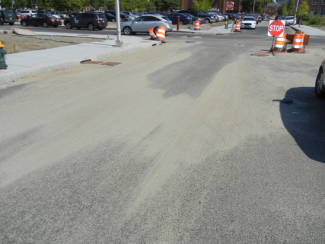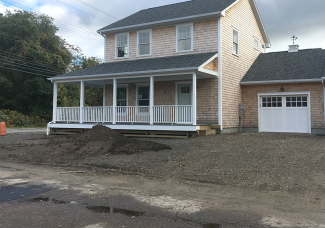Spot Stormwater Violations around a Construction Area
Construction sites are required to install and maintain control measures that prevent soil erosion. Soil erosion happens when water, wind, or gravity move soil from one location to another. The control measures ensure public safety, help keep local waters clean, and prevent flooding, soil loss, and other long-term consequences of erosion.
Look familiar? Contact your Stormwater Manager if you see a violation illustrated in the “Please Report” column. Use the “All Good!” column to learn about the Best Management Practices that contain and control soil erosion.
For immediate assistance contact the RI DEM Office of Compliance and Inspection at (401) 537-4533 or DEM.Compliance2@dem.ri.gov.

PLEASE REPORT
Muddy water is an illicit discharge and a violation of the Soil Erosion and Sediment Control plan.

ALL GOOD!
Filter fabrics on storm drains are a last line of defense against erosion entering waterways. Photo credit: US EPA.

PLEASE REPORT
Compost filter socks are highly effective. However sediment must be cleared away regularly or it will pile up and eventually be carried over the compost filter sock.

ALL GOOD!
Filter sock appropriately placed between construction and a wetland. Area is free of accumulated sediment.

PLEASE REPORT
Concrete outwash, which is highly toxic to aquatic life, has been carried by runoff to the storm drain at left.

ALL GOOD!
Designated concrete wash out areas allow for management of polluted water from washing out ready-mix trucks, drums, and pumps.

PLEASE REPORT
Sediment tracked into roadways from construction site entrances presents a public safety hazard.

ALL GOOD!
A well-maintained pad of crushed stone has been placed where construction vehicles pull into and out of site. Photo credit: iowastormwater.org

PLEASE REPORT
A small construction site with no visible erosion control measures. Photo credit: iowastormwater.org

ALL GOOD!
A good way to prevent soil erosion at the source is the straw mulching at right. Photo credit: Barry Tonning at Tetra Tech.

PLEASE REPORT
This tree has no protection from excavation and stockpiles. This will result in damage to the roots which may cause it to die.

ALL GOOD!
Tree is protected out to drip line (outermost circumference of a tree canopy) by robust fence.

PLEASE REPORT
Uncovered dumpsters may allow pollutants to drain out with rain water. Photo credit: RI NEMO.

ALL GOOD!
Dumpster properly covered with ends weighted down.

PLEASE REPORT
Disturbed sediment on a slope has been eroding away under wet weather conditions

ALL GOOD!
Sediment control blankets can be installed on slopes to prevent erosion.

PLEASE REPORT
The lot at left is ringed with silt fencing, but the addition of mulch would make this measure even more effective. Photo credit: Barry Tonning at Tetra Tech.

ALL GOOD!
Straw mulching prevents soil erosion at the source and is also cost effective. Photo credit: iowastormwater.org

PLEASE REPORT
With no measures to intercept them, the exposed and uncovered soils on this construction site are being washed directly into the road. Photo credit: RI NEMO.

ALL GOOD!
If a project is going to be halted during the growing season, dirt stockpiles are sometimes seeded to keep the sediment in place. Photo credit: US EPA.
